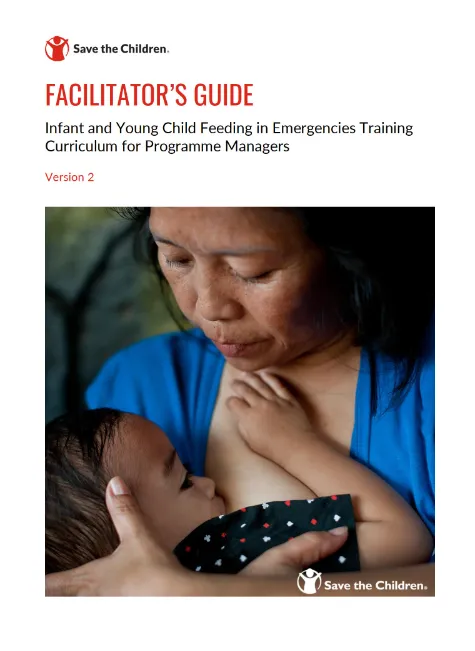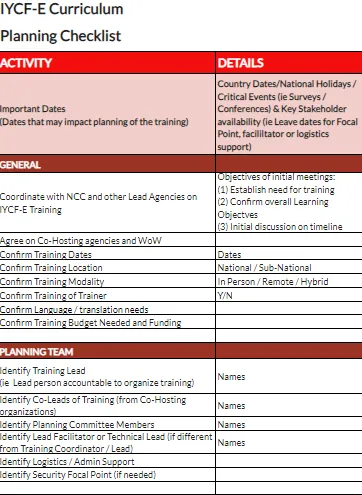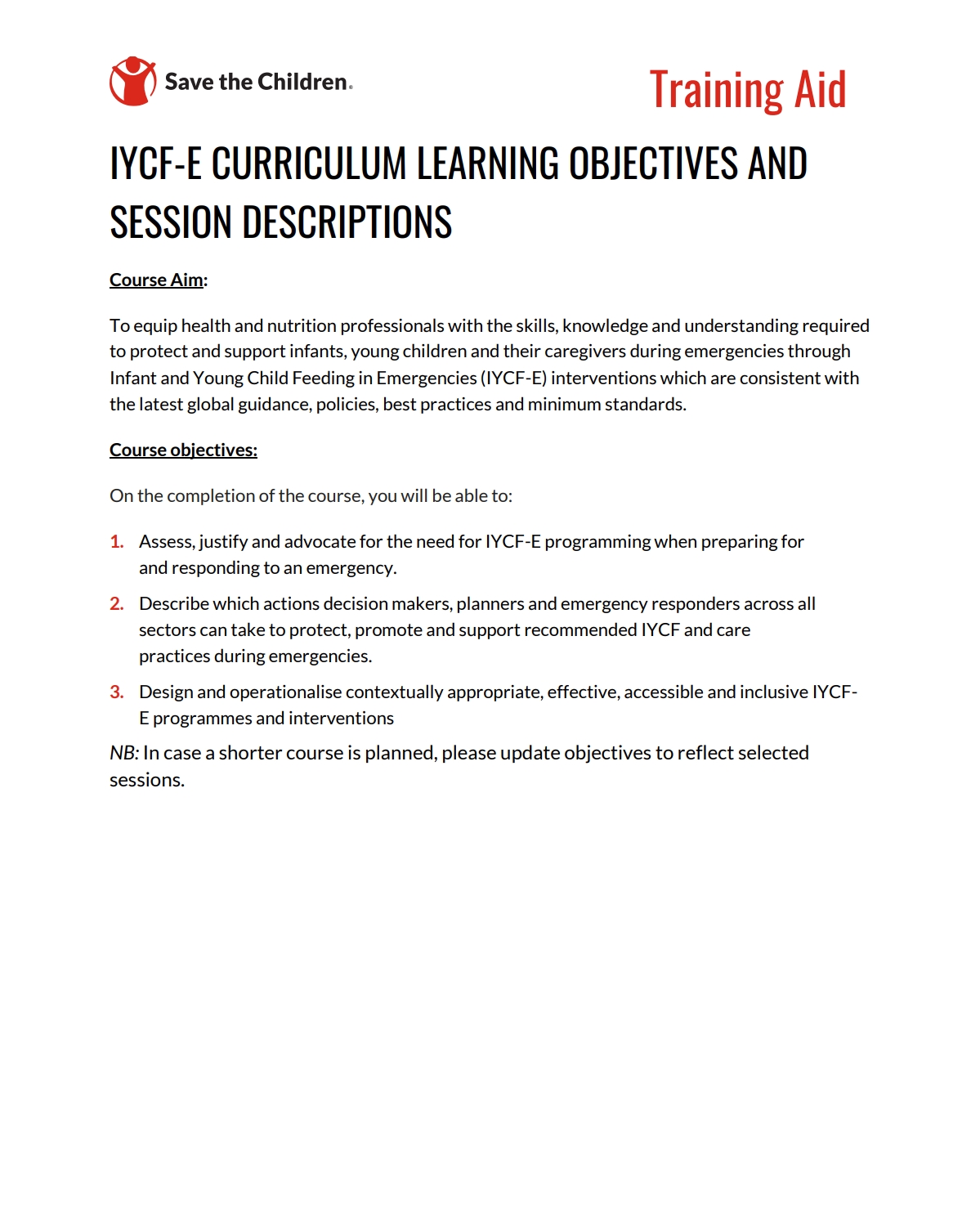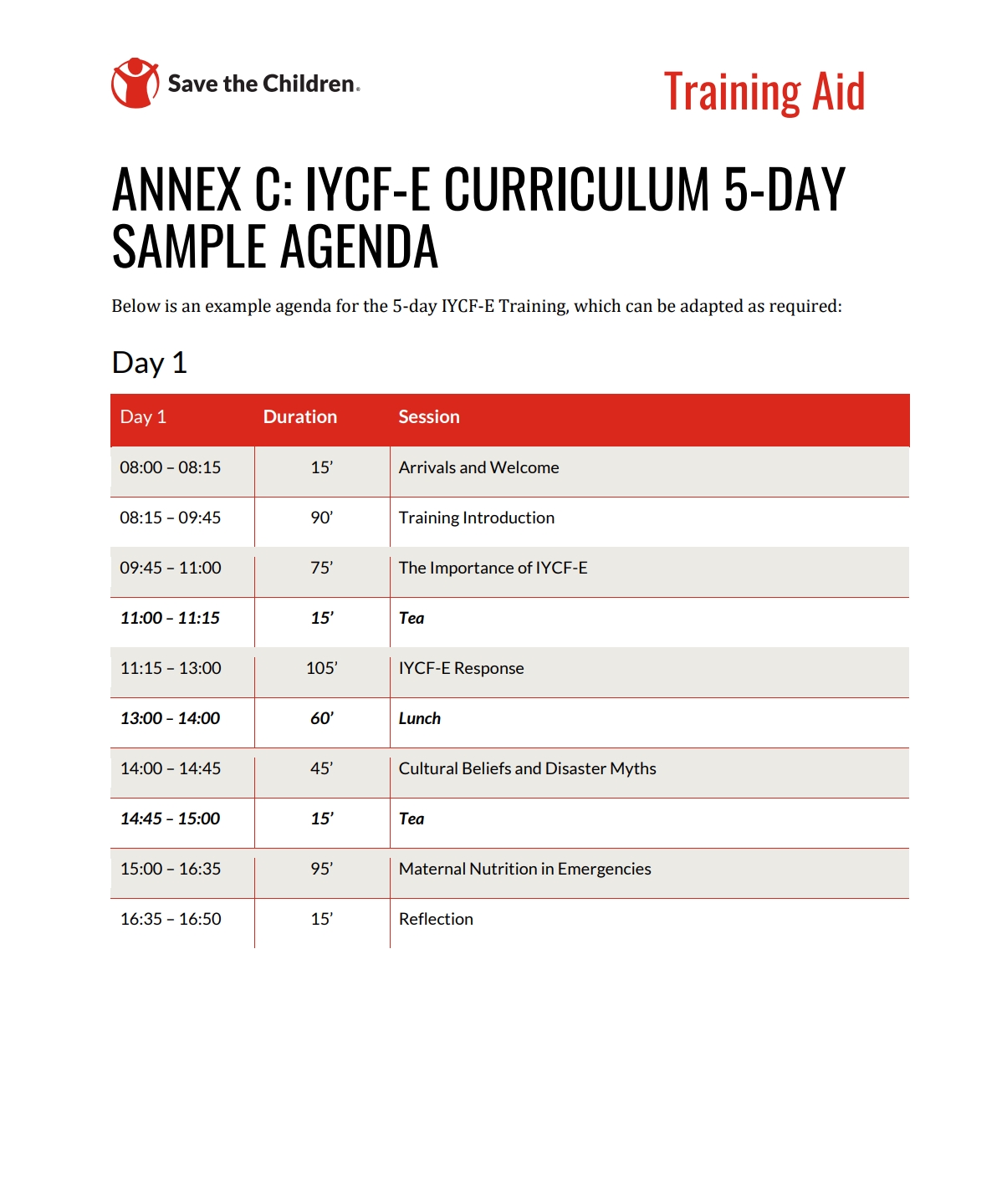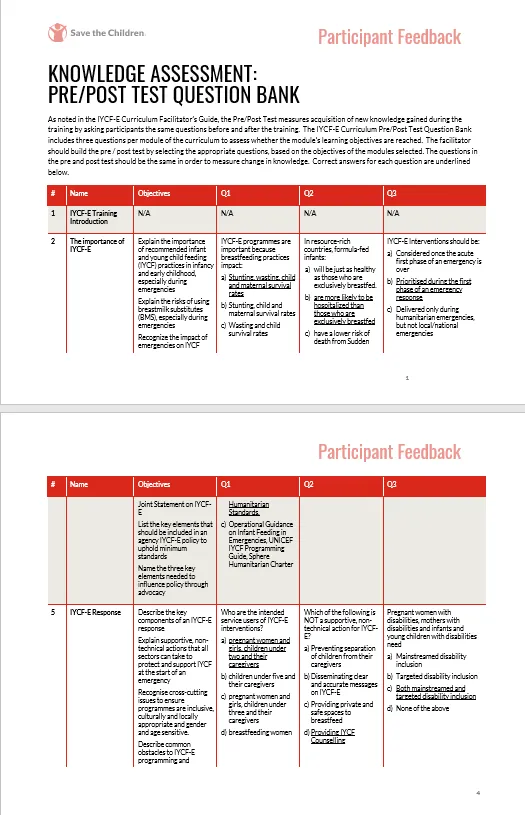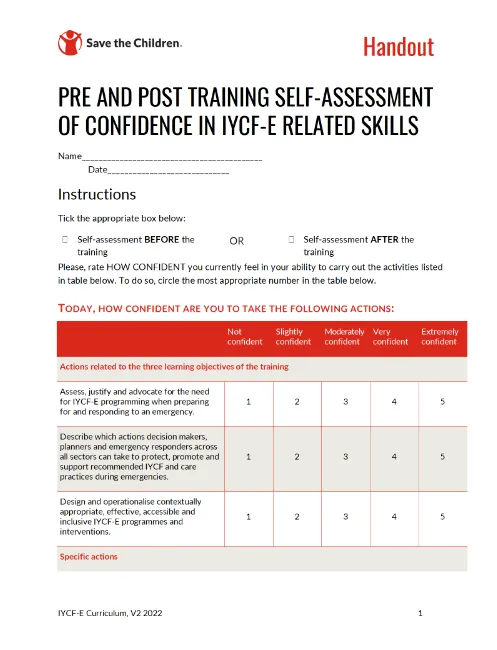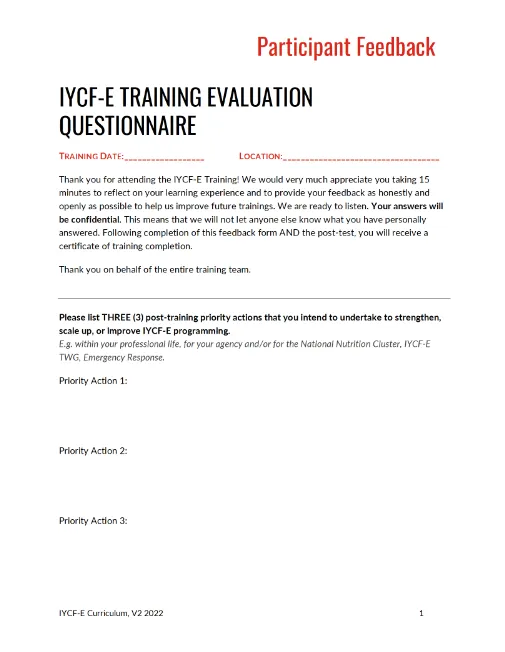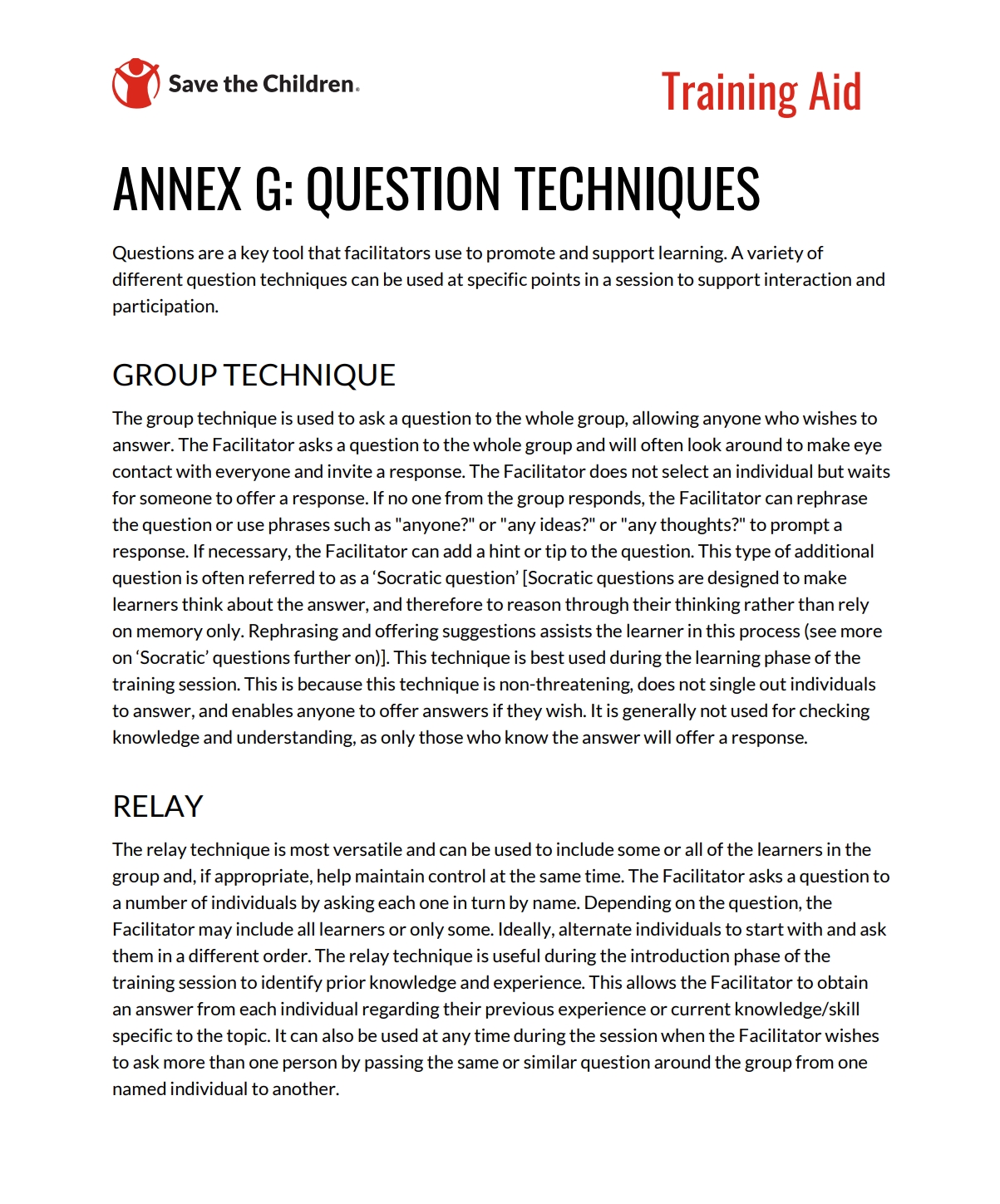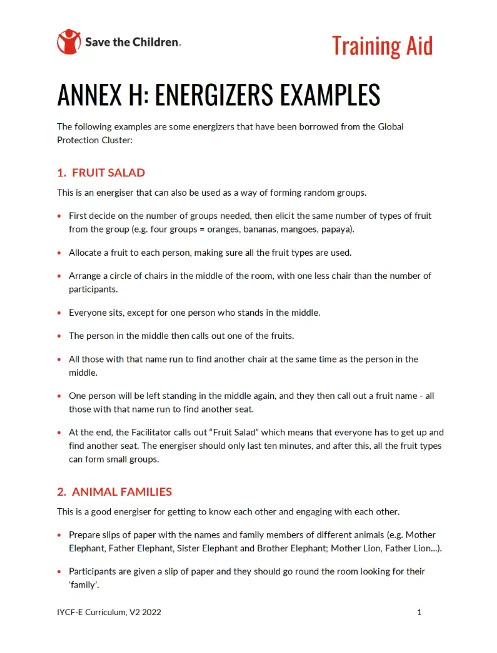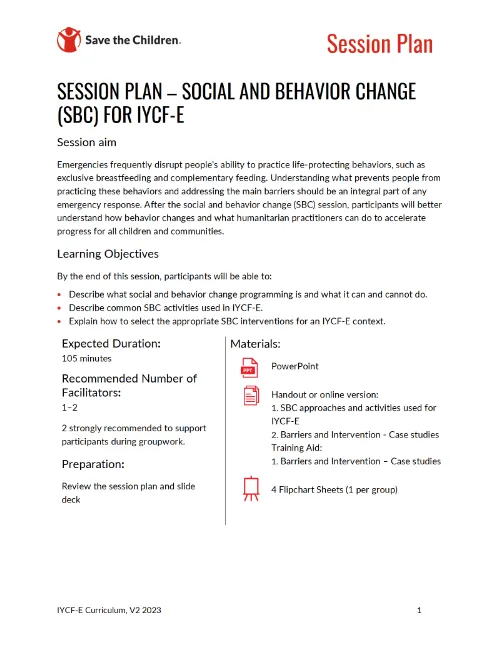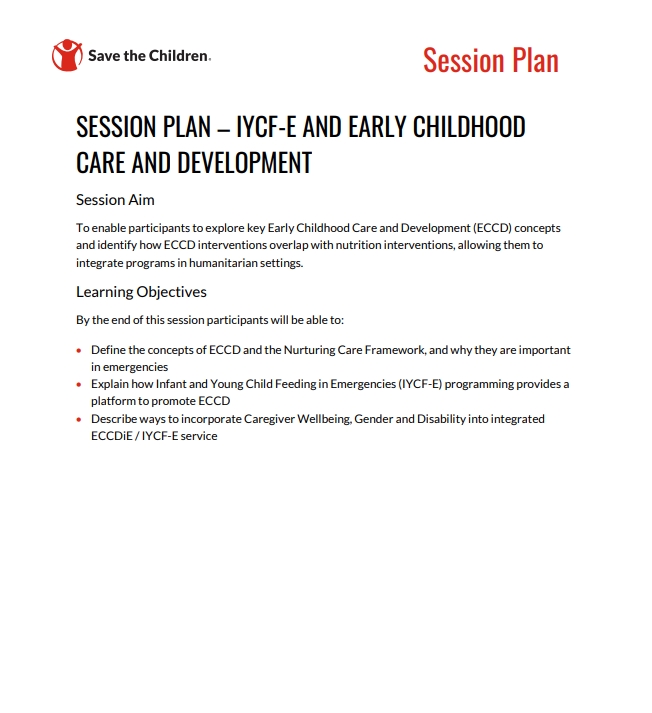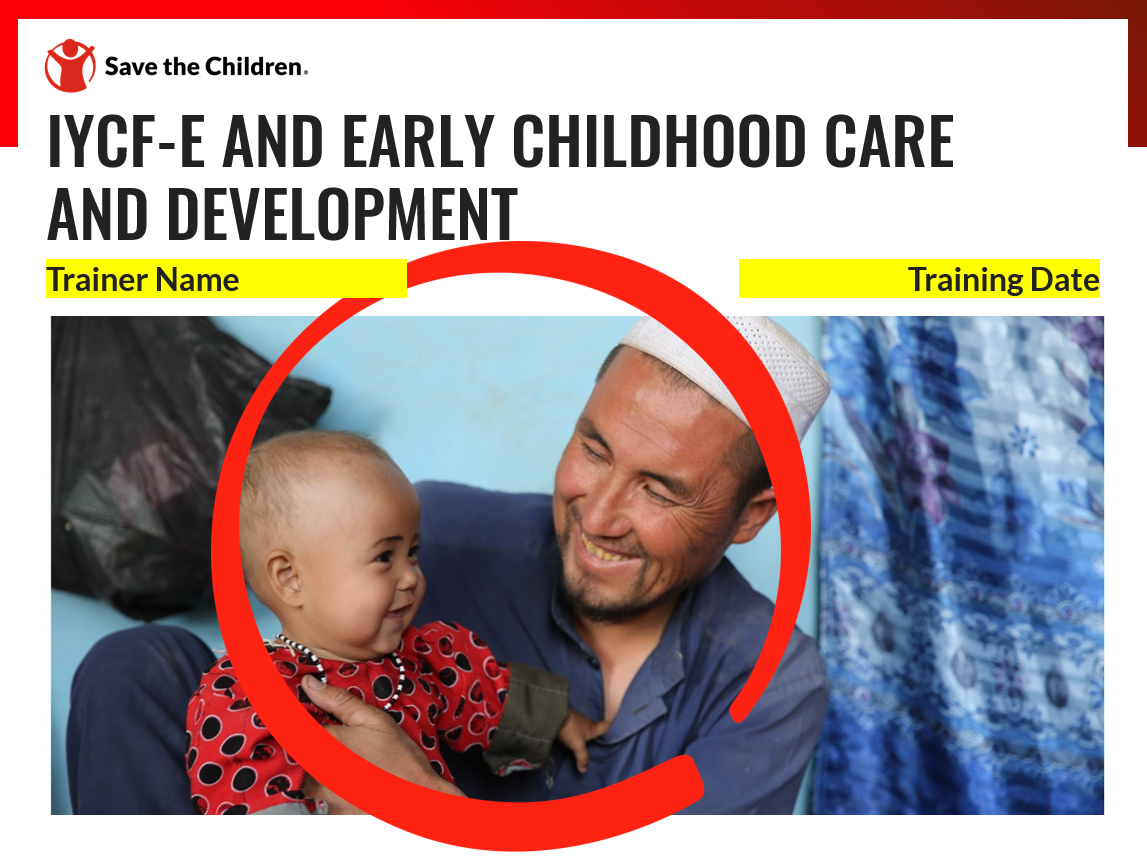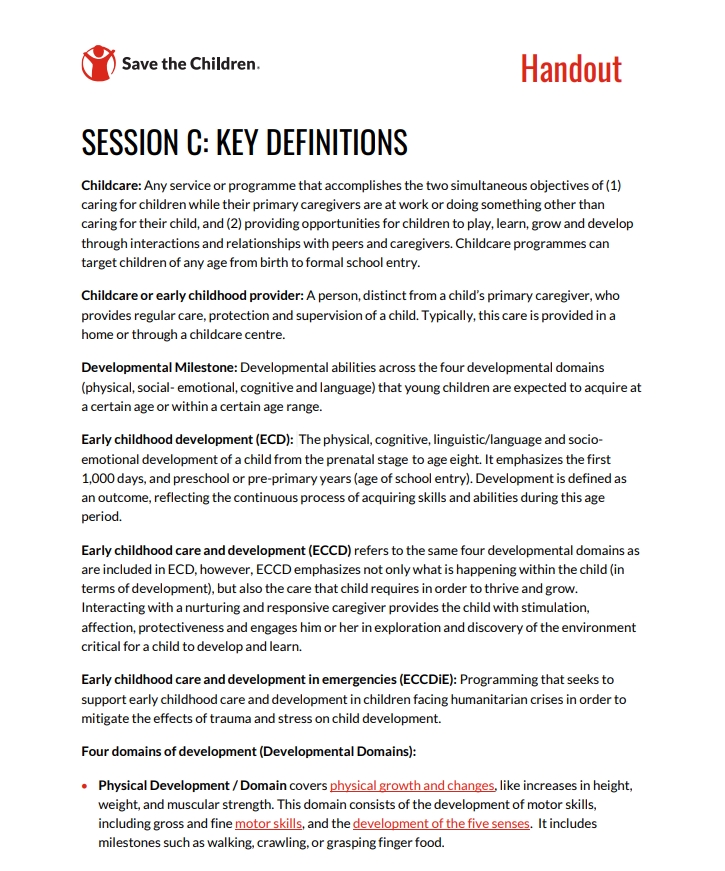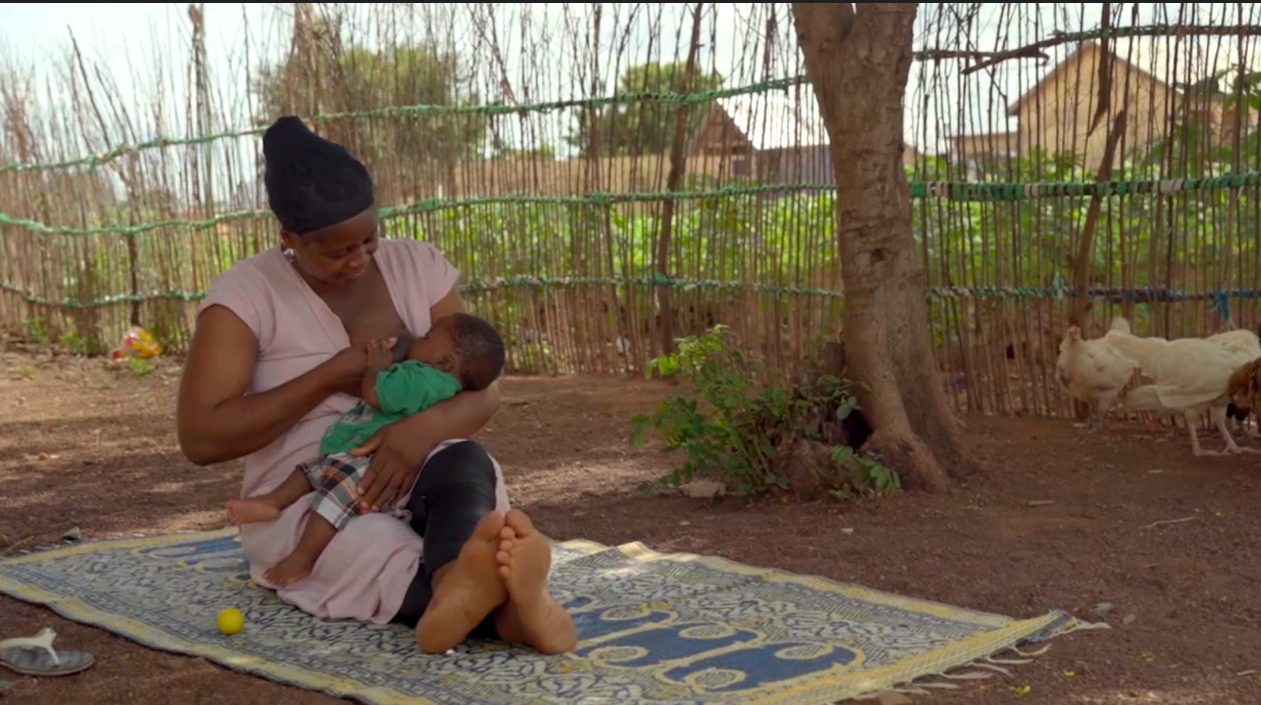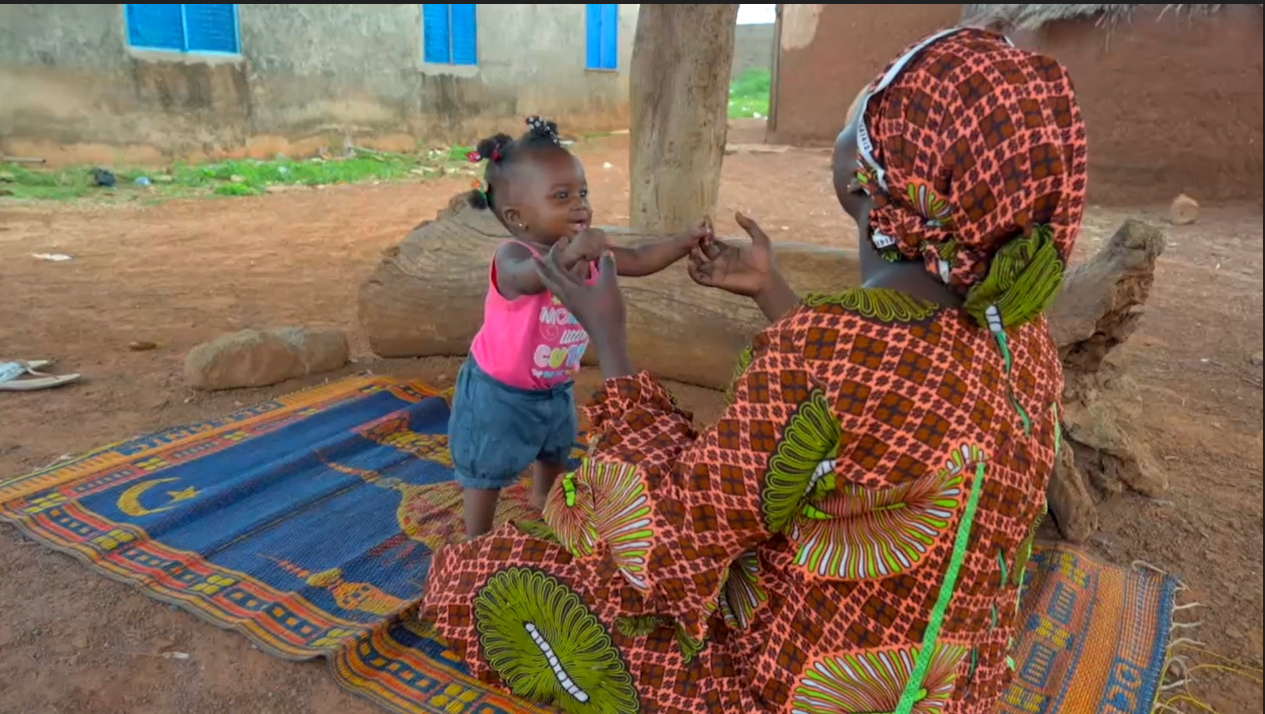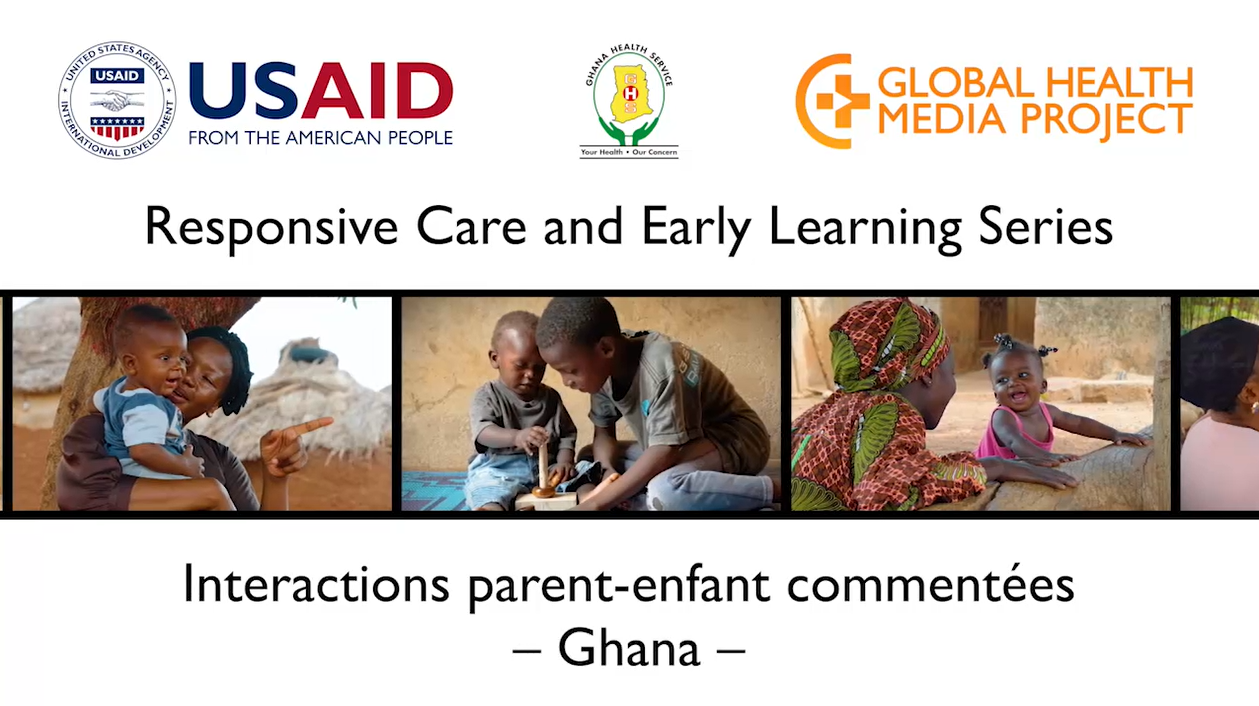Infant and Young Child Feeding in Emergencies (IYCF-E) Curriculum for Programme Managers, Version 2.
Share:
Save the Children (SC) has developed the Infant and Young Child Feeding in Emergencies Training Curriculum for Programme Managers (also known as the “IYCF-E Curriculum”) with the aim to equip health and nutrition professionals with the skills, knowledge, and understanding required to protect and support infants, young children, and their caregivers during emergencies through IYCF-E interventions which are consistent with the latest global guidance, policies, best practices, and minimum standards.
It can be used as an in-depth regional, country, and/or organisational level training to develop and enhance an individual’s ability to manage or contribute towards the development and implementation of an IYCF-E programme. It can be adapted to a specific context and made more relevant as needed.
Upon completing the full curriculum, participants will be able to do the following:
- Assess, justify, and advocate for the need for IYCF-E programming when preparing for and responding to an emergency.
- Describe which actions decision-makers, planners, and emergency responders across all sectors can take to protect, promote, and support recommended IYCF and care practices during emergencies.
- Design and operationalise contextually appropriate, effective, accessible, and inclusive IYCF-E programmes and interventions.
The IYCF-E Curriculum includes 26 sessions: 15 core sessions and 11 optional sessions. Click on the links below to discover the content of the sessions.
Don’t miss our newest session here: New: IYCF-E and Early Childhood Care and Development.
This training package is available in English, Spanish, French, and Arabic. To access the other languages, click on language then on the desired language.
Download the flyer in English | Spanish | French | Arabic
To provide feedback, contact: iycfe@savethechildren.org
ACKNOWLEDGEMENTS: This IYCF-E Curriculum was developed by Save the Children with technical input and review by members of the Infant Feeding in Emergencies Core Group and other IYCF-E experts. The IYCF-E Curriculum Version 2 was made possible thanks to the generous support of the American people through funding by the United States Agency for International Development (USAID). The contents are the responsibility of Save the Children and the IFE Core Group and do not necessarily reflect the views of USAID or the United States Government.
Save the Children welcomes partners to utilize this curriculum to support quality IYCF-E programming through capacity strengthening activities. All elements of the curriculum are copyrighted but may be reproduced with appropriate acknowledgments by any method without fee or prior permission for teaching purposes, but not for resale.
Chapter 0
Facilitators Guide and Training Tools
Facilitators Guide and Training Tools
9 resources
Chapter 1
1. Training Introduction
This session is 90 minutes long and aims to introduce participants to the training and discuss expectations.
By the end the session, participants will be able to:
1. Outline the course aim, objectives and learning journey
2. Know your trainers and other participants
3. Address your expectations, concerns and questions and jointly agree on ways of learning and working together
Training Introduction
5 resources
Chapter 2
2. The Importance of IYCF-E
This session is 75 minutes long and aims to enable participants to recognize the importance of IYCF-E in general and their context specifically, so they can justify and advocate for IYCF-E in current and future emergency responses. By the end the module, participants will be able to:
1. Explain the importance of recommended infant and young child feeding (IYCF) practices in infancy and early childhood, especially during emergencies
2. Explain the risks of using breastmilk substitutes (BMS), especially during emergencies
3. Recognize the impact of emergencies on IYCF practices and the need for IYCF-E interventions.
The Importance of IYCF-E
6 resources
Chapter 3
3. Cultural Beliefs and Disaster Myths
This session is 45 minutes long and aims to enable participants to recognize the importance of IYCF-E in general and their context specifically, so they can justify and advocate for IYCF-E in current and future emergency responses. By the end of the module, participants will be able to:
1. Explain the importance of recommended infant and young child feeding (IYCF) practices in infancy and early childhood, especially during emergencies
2. Explain the risks of using breastmilk substitutes (BMS), especially during emergencies
3. Recognise the impact of emergencies on IYCF practices and the need for IYCF-E interventions.
Cultural Beliefs and Disaster Myths
2 resources
Chapter 4
4. Policies, Legislations, and Guidelines
This session is 75 minutes long and aims to orient participants to relevant policies, guidelines and recommendations so that they can verify that IYCF-E programmes are aligned. By the end the module, participants will be able to:
1. Describe global and national IYCF / IYCF-E policies, legislation, strategies and guidelines and any gaps in national documentation
2. Demonstrate understanding of the central importance of the Operational Guidance on Infant and Young Child Feeding in Emergencies and the The International Code of Marketing of Breastmilk Substitutes (“The Code”)
3. List the key content and key steps for issuing a Joint Statement on IYCF-E
4. List the key elements that should be included in an agency IYCF-E policy to uphold minimum standards
5. Name the three key elements needed to influence policy through advocacy
Policies, Legislations, and Guidelines
6 resources
Chapter 5
5. IYCF-E Response
This session is 105 minutes long and aims to provide participants with an overview of a comprehensive Infant and Young Child Feeding in Emergencies (IYCF-E) response and explore actions decision makers, planners and emergency responders across all sectors can take to protect, promote and support infants and young children during emergencies. By the end the session, participants will be able to:
1. Describe the key components of an IYCF-E response
2. Explain supportive, non-technical actions that all sectors can take to protect and support IYCF at the start of an emergency
3. Recognise cross cutting issues to ensure programmes are inclusive, culturally and locally appropriate and gender and age sensitive.
4. Describe common obstacles to IYCF-E programming and recognise appropriate mitigation strategies
5. Recognise the similarities and differences between Infant and Young Child Feeding (IYCF) and IYCF-E programmes.
IYCF-E Response
15 resources
Chapter 6
6. Maternal Nutrition in Emergencies
This 95 minute session aims to enable participants to demonstrate an understanding of the nutritional needs of pregnant and lactating women (PLWs), to recognize the importance of maternal nutrition in emergencies, and to ensure contextually appropriate nutritional support for PLWs in an emergency. By the end the module, participants will be able to:
1. Describe the nutritional needs, and drivers of malnutrition in pregnant and lactating women during emergencies.
2. Articulate the importance of protecting nutrition in pregnant and lactating women in order to protect and support their health and wellbeing, as well as recommended IYCF practices, and to break inter-generational cycles of growth failure.
3. Describe interventions and emerging innovative practice that protect, promote and support optimal nutrition during pregnancy and breastfeeding in women.
Maternal Nutrition in Emergencies
2 resources
Chapter 7
7. Complementary Feeding in Emergencies
2. Describe challenges with complementary feeding that may be encountered during an emergency
3. Identify contextually appropriate interventions to protect, promote and support recommended complementary feeding practices alongside continued breastfeeding during an emergency
Complementary Feeding in Emergencies
7 resources
Chapter 8
8. Breastfeeding in Emergencies
This 90-minute session aims to ensure participants have key knowledge about breastfeeding physiology, in relation to how breastfeeding may therefore be disrupted during an emergency and what can be done to protect and support it. By the end of the module, participants will be able to:
1. Recall how breastfeeding works (lactation physiology) and state ways to support it to work well
2. Identify ways in which breastfeeding may be disrupted or undermined during an emergency
3. State the minimum standards and key interventions for protecting, promoting, and supporting breastfeeding in an emergency
Breastfeeding in Emergencies
5 resources
Chapter 9
9. Social and Behavior Change for IYCF-E
Emergencies frequently disrupt people’s ability to practice life-protecting behaviors, such as exclusive breastfeeding and complementary feeding. Understanding what prevents people from practicing these behaviors and addressing the main barriers should be an integral part of any emergency response. After this 105-minutes session, participants will better understand how behavior changes and what humanitarian practitioners can do to accelerate progress for all children and communities. By the end the module, participants will be able to: 1. Describe what social and behavior change programming is and what it can and cannot do. 2. Describe common SBC activities used in IYCF-E. 3. Explain how to select the appropriate SBC interventions for an IYCF-E context.
Social and Behavior Change for IYCF-E
5 resources
Chapter 10
10. IYCF Counselling in Emergencies
This 120-minute session aims to enable participants to design and operationalise contextually appropriate, inclusive and accessible Infant and Young Child Feeding (IYCF) Counselling services in accordance with global guidance and guidelines. By the end of the module, participants will be able to:
1. Explain what IYCF Counselling is and why it is an important, priority intervention during emergencies
2. Use key global guidance documents to design and operationalise contextually appropriate IYCF counselling programmes
3. Recognise common challenges and identify acceptable compromises and adaptations for delivering IYCF counselling in emergency settings
IYCF Counselling in Emergencies
13 resources
Chapter 11
11. Relactation, Wet Nursing and Donor Human Milk in Emergencies
This 120-minute session aims to enable participants to understand key aspects of managing non-breastfed and partially breastfed children and to identify and operationalise contextually appropriate interventions to provide safer alternatives to infant formula. By the end the module, participants will be able to:
1. Explain why it is important to first explore infant feeding options other than breastmilk substitutes
2. Identify alternative feeding options to breast milk substitutes that minimise risk for non-breastfed and partially breastfed infants and assess their contextual appropriateness and feasibility for a given emergency context
3. Design and operationalise interventions to facilitate alternative feeding options for non-breastfed and partially breastfed infants in emergencies
Relactation, Wet Nursing and Donor Human Milk in Emergencies
12 resources
Chapter 12
12. Supporting Breastmilk Substitute (BMS)-dependent Children in Emergencies
This 120-minute session aims to enable participants to understand key aspects of managing non-breastfed children and to design and operationalise interventions to provide appropriate Breastmilk Substitute (BMS) support for infants in exceptional circumstances while taking measures to minimize risks. By the end of the module, participants will be able to:
1. Assess and justify the need for BMS programming in an emergency
2. Explain how to design and implement a contextually appropriate BMS management programme in accordance with global guidance and the Code
3. Describe how to minimise risks associated with the use of BMS in emergencies
4. Specify the key supplies for a BMS programme
Supporting Breastmilk Substitute (BMS)-dependent Children in Emergencies
5 resources
Chapter 13
13. Caregiver Wellbeing and IYCF-E
This 120-minute session aims to enable participants to ensure that Infant and Young Child Feeding in Emergencies (IYCF-E) programmes do no harm and support maternal/caregiver wellbeing in contextually appropriate ways. By the end of the module, participants will be able to:
1. Explain the importance of Mental Health and Psychosocial Support (MHPSS) in relation to IYCF-E
2. Identify how MHPSS can be integrated into IYCF-E programmes
3. Describe simple ways to provide trauma-informed care within IYCF-E programmes
Caregiver Wellbeing and IYCF-E
8 resources
Chapter 14
14. Action Planning
This 90-minute session aims to maximise the impact of this training, the purpose of this final session is to support the translation of learning into actions which will strengthen the Infant and Young Child Feeding in Emergencies (IYCF-E) Response(s) which participants are involved in. The output of this final session will be an IYCF-E action plan for the IYCF-E Coordination mechanism to implement, which identifies what participants can contribute as individuals and via the agencies they work for. By the end the module, participants will be able to:
1. Explain how you will apply your newly acquired IYCF-E skills and knowledge to your daily work to contribute to strengthening IYCF-E capacity within your agency
2. Use the IYCF-E Capacity Assessment Tool and process in order to plan and conduct regular IYCF-E Capacity Assessments at agency and cluster/sector level.
3. Detect gaps in IYCF-E capacity and present a joint plan which identifies specific capacity strengthening actions to improve and scale up IYCF-E Preparedness/Response
Action Planning
3 resources
Chapter 15
15. Training Completion
This 75-minute session aims conclude the training, complete post assessment forms, and distribute certificates if relevant. By the end of this session participants will be able to:
1. Determine whether the learning objectives and their expectations for the training were met
2. Assess whether their knowledge, understanding and confidence in IYCF-E has increased
3. Provide feedback regarding the training curriculum and its delivery
4. Receive their certificate
Training Completion
2 resources
Chapter 16
A. IYCF-E Coordination
This 90-minute session aims to support participants to confidently engage with and utilise Infant and Young Child Feeding in Emergencies (IYCF-E) Coordination mechanisms and actively contribute to strengthening coordination during emergencies. By the end the module, participants will be able to:
1. Explain the purpose and importance of IYCF-E coordination
2. Identify the main actors and structures with IYCF-E coordination responsibilities
3. Determine the current level of coordination capacity in your operating context
4. Identify key tools and approaches to support effective IYCF-E coordination
IYCF-E Coordination
3 resources
Chapter 17
B. Early Initiation of Breastfeeding in Emergencies
This 120-minute session aims to enable participants to support the early initiation of exclusive breastfeeding within maternity services during emergencies.
By the end the module, participants will be able to:
1. State key newborn interventions to protect and support maternal and newborn health and nutrition status
Describe the possible impact of emergencies on the practice of early initiation of exclusive breastfeeding
3. Describe the Ten Steps to Successful Breastfeeding that should be integrated into maternity services during emergencies
4. Identify barriers and solutions to implementing interventions to support early initiation of breastfeeding during emergencies
Early Initiation of Breastfeeding in Emergencies
7 resources
Chapter 18
C. IYCF-E and ECCD
This 100-minute session aims to enable participants to explore key Early Childhood Care and Development (ECCD) concepts and identify how ECCD interventions overlap with nutrition interventions, allowing them to integrate programs in humanitarian settings.
By the end the module, participants will be able to:
1. Define the concepts of ECCD and the Nurturing Care Framework, and why they are important in emergencies
2. Explain how IYCF-E programming provides a platform to promote ECCD
3. Describe ways to incorporate Caregiver Wellbeing, Gender and Disability into integrated ECCDiE / IYCF-E service
IYCF-E and ECCD
12 resources
Chapter 19
D. Integration and Multisector Support
This 90-minute session aims to provide guidance to participants on what needs to be considered to create an “Infant and Young Child Feeding (IYCF) friendly” environment and facilitate appropriate IYCF during emergencies, specifically though multi-sectoral integration of IYCF sensitive activities across sectors.
Integration and Multisector Support
8 resources
Chapter 20
E. IYCF-E Situational Analysis and Needs Assessment
This 105-minute session aims to enable participants to contribute to identifying what Infant and Young Child Feeding in Emergencies (IYCF-E) data is needed, what exists and what needs to be updated; to collect, analyze and interpret IYCF-E data as part of needs assessments, and to disseminate and communicate data to inform decision making. By the end of the module, participants will be able to:
1. Select an appropriate IYCF-E assessment methodology, depending on the context and phase of the emergency.
2. Define and select key IYCF-E indicators and their definitions
3. Recognise early assessment alerts which indicate that further investigation and/or urgent action is needed
4. Collaborate with other actors to align methods, tools and indicators and design, plan and organise IYCF-E assessments
Session Plan: IYCF-E Situational Analysis and Needs Assessment
3 resources
Chapter 21
F. Preventing and Managing Harmful Donations in Emergencies
This 100-minute session aims to enable participants to understand why certain products should never be solicited, accepted or donated in emergencies and what can be done to prevent this from occurring and / or to reduce harm by intercepting and handling donations. By the end the module, participants will be able to:
1. List categories of products that should not be solicited or accepted as donations during emergencies.
2. Explain why it is important to comply with The Code and the OG-Infant Feeding in Emergencies with regards to donations in emergencies.
3. Identify ways in which inappropriate and harmful donations can be prevented.
4. Monitor for and report inappropriate donations and other Code violations.
5. Develop a contextually appropriate plan to manage unprevented donations.
Preventing and Managing Harmful Donations in Emergencies
10 resources
Chapter 22
G. IYCF-E Media Communication
This 60-minute session aims to improve the quality of mass media, communications and advocacy activity on Infant and Young Child Feeding in Emergencies (IYCF-E). By the end of the module, participants will be able to:
1. Explain how mass media communication can influence IYCF perceptions and practice during emergencies
2. State which key Communications & Advocacy actions to take at each stage of an emergency response
3. Identify and communicate key IYCF-E messages and narratives that are required for effective communication to positively impact IYCF outcomes
Infant and Young Child Feeding in Emergencies Media Communication
3 resources
Chapter 23
H. IYCF-E Staffing and Capacity Strengthening
This 75-minute session aims to enable participants to identify, utilize and strengthen existing Infant and Young Child Feeding in Emergencies (IYCF-E) capacities as well as addressing capacity gaps where they exist. By the end the module, participants will be able to:
1. Identify who can provide IYCF-E services in an emergency
2. Describe common challenges with staffing IYCF-E programmes and identify possible solutions
3. Describe the key steps for conducting an IYCF-E Capacity Mapping and Assessment exercise and developing an IYCF-E Capacity Building Plan (for your organisation / the collective)
4. Locate materials to support training, sensitization and recruitment of staff
5. Recognise how to access IYCF-E technical advice and support at national, regional and global level
6. Explain how to champion and strengthen local and national capacity and to avoid activities or ways of working which inadvertently reinforce harmful power dynamics.
IYCF-E Staffing and Capacity Strengthening
5 resources
Chapter 24
I. IYCF-E & HIV
This 90-minute session aims to introduce participants to key principals and considerations for integration of Infant and Young Child Feeding in Emergencies (IYCF-E) and HIV programming during emergencies. By the end of the module, participants will be able to:
1. Explain the concept of HIV free child survival
2. Apply global guidelines and recommendations for IYCF and HIV in emergencies
IYCF-E & HIV
5 resources
Chapter 25
J. IYCF-E During Infectious Disease Outbreak
This 90-minute session aims to enable participants to ensure that infants and young children are adequately protected and supported during infectious disease outbreaks through appropriate feeding recommendations and adequate multi-sector Infant and Young Child Feeding (IYCF)-sensitive activities. By the end of the module, participants will be able to:
1. Describe the importance of IYCF during infectious disease outbreaks
2. Anticipate and assess the impact of infectious disease outbreaks on IYCF
3. Explain the key principles for developing infant feeding recommendations for an infectious disease.
4. List key actions to take to mitigate the impact of an infectious disease outbreak on IYCF practices.
IYCF-E During Infectious Disease Outbreak
8 resources
Chapter 26
K. Supportive Spaces for IYCF-E
This 60-minute session aims to provide participants with an overview of how supportive spaces for Infant and Young Child Feeding in Emergencies (IYCF-E) can be used to deliver various services and activities for children under two and their caregivers and to enable participants to design and operationalise safe, accessible and inclusive services. By the end the module, participants will be able to:
1. Decide whether supportive spaces are needed and appropriate
2. Describe the different kinds of supportive spaces for IYCF-E and activities/services that can be provided within these spaces.
3. Design and operationalise supportive spaces for IYCF-E which are contextually appropriate, safe, accessible and inclusive.
Supportive Spaces for Infant and Young Child Feeding in Emergencies
4 resources

